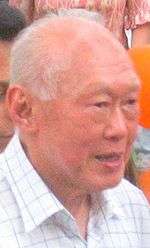Singaporean general election, 1984
| | |||||||||||||||||||||||||||||||||||||||||||||||||||||||
| |||||||||||||||||||||||||||||||||||||||||||||||||||||||
| |||||||||||||||||||||||||||||||||||||||||||||||||||||||
| |||||||||||||||||||||||||||||||||||||||||||||||||||||||
.svg.png) |
| This article is part of a series on the politics and government of Singapore |
| Constitution |
| Foreign relations |
|
Related topics |
General elections were held in Singapore on 22 December 1984. The result was a victory for the People's Action Party, which won 77 of the 79 seats, marking the first time since 1963 that they had not won every seat. Voter turnout was 95.6%, although this figure represents the turnout in the 49 constituencies to be contested,[1] with PAP candidates earning walkovers in the other 30.
Background
In his 1983 National Day Rally speech, Prime Minister Lee Kuan Yew lamented that declining birth rates and large number of graduate women remaining single or not marrying their intellectual equal could see Singapore's talent pool shrink. The PAP government then proceeded to launch the "Graduate Mother Scheme" to entice graduate women with incentives to get married. These were said to have caused a big dip in PAP's support for this GE and its share of votes plunged by more than 10% to below 70%, the biggest fall and the lowest for PAP since the 1963 General Election.
No by-election was held for the seat of Havelock, vacated in 1983 upon the passing away of Minister of Finance Hon Sui Sen, for the reason that the constituency will be redrawn and merged into Delta constituency.
PM Lee's son and future prime minister Lee Hsien Loong made his debut in the seat of Teck Ghee, while PAP stalwarts Dr Goh Keng Swee and Ong Pang Boon stepped down. In the only election among several preceding and succeeding ones, election deposit remained unchanged. The Workers' Party of Singapore (WP) retained, with an increased majority, its sole Anson seat of leader J. B. Jeyaretnam while the Singapore Democratic Party made its first in-road into Parliament with the victory of Chiam See Tong, who would hold on to the Potong Pasir Single Member Constituency in many years to come. A new Non-Constituency Member of Parliament scheme was introduced whereby between three and six seats, the exact number decided by the President of Singapore, would be offered to unsuccessful opposition candidates with the best scores and who garner at least 15% of the votes if any one party wins all the seats, subtracting one NCMP seat for every one opposition MP elected. Opposition parties dismissed the scheme for misleading voters into thinking that they could have opposition MPs without voting for them. WP's candidate M.P.D. Nair was eligible for NCMP but declined, which was then offered to the Singapore United Front's Tan Chee Kien, who did the same, and no further offers were made.
The newer constituencies are those with rapid developments of Ang Mo Kio, Tampines, Jurong East, Bedok & Jurong West (smaller developments):
- Bo Wen (from parts of Ang Mo Kio, Kebun Baru & Yio Chu Kang)
- Changkat (from parts of Tampines & Kaki Bukit)
- Eunos (from parts of Kaki Bukit & Tampines)
- Fengshan (from parts of Bedok, Kampong Chai Chee & Tanah Merah)
- Hong Kah (from Boon Lay)
- Teck Ghee (from parts of Ang Mo Kio & Chong Boon)
- Yuhua (from parts of Boon Lay & Bukit Timah)
Retirement from politics
- Chan Chee Seng (Jalan Besar)
- Chau Sik Ting (Thomson)
- Chiang Hai Deng (Ulu Pandan)
- Chor Yeok Eng (Bukit Timah)
- Goh Keng Swee (Kreta Ayer)
- Ho See Beng (Khe Bong)
- Howe Yoon Chong (Potong Pasir)
- Hwang Soo Jin (Jalan Kayu)
- Joseph Francis (Katong) - removed constituency
- K.A. Jabbar (Radin Mas)
- K C Lee (Braddell Heights)
- Michael Liew (Boon Teck)
- P Selvadurai (Kuo Chuan)
- Rohan Kamis (Telok Blangah)
- Seah Mui Kok (Bukit Ho Swee) - removed constituency
- Sia Kah Hui (Paya Lebar)
New MPs
- Abdullah Tarmugi
- Aline Wong
- Arthur Beng
- Chiam See Tong
- Dixie Tan
- Goh Choon Kang
- Heng Chiang Meng
- Ho Tat Kin
- Koh Lam Son
- Lee Boon Yang
- Lee Hsien Loong
- Leong Horn Kee
- Philip Tan
- S Vasoo
- Tang Guan Seng
- Wang Kai Yuen
- Wong Kan Seng
- Yatiman Yusof
- Yeo Cheow Tong
- Zulkifi Mohammad
Results
| Party | Votes | % | Seats | +/– |
|---|---|---|---|---|
| People's Action Party | 568,310 | 64.8 | 77 | +2 |
| Workers' Party | 110,939 | 12.7 | 1 | +1 |
| Singapore United Front | 87,197 | 9.9 | 0 | 0 |
| Singapore Democratic Party | 32,102 | 3.7 | 1 | +1 |
| United People's Front | 27,217 | 3.1 | 0 | 0 |
| Barisan Sosialis | 24,212 | 2.8 | 0 | 0 |
| Singapore Justice Party | 10,906 | 1.2 | 0 | 0 |
| Singapore Malay National Organisation | 4,768 | 0.5 | 0 | 0 |
| Angkatan Islam | 359 | 0.0 | 0 | New |
| Independents | 10,586 | 1.2 | 0 | New |
| Invalid/blank votes | 26,384 | – | – | – |
| Total | 909,980 | 100 | 79 | +4 |
| Source: Nohlen et al. | ||||
References
- ↑ Dieter Nohlen, Florian Grotz & Christof Hartmann (2001) Elections in Asia: A data handbook, Volume II, p255 ISBN 0-19-924959-8

